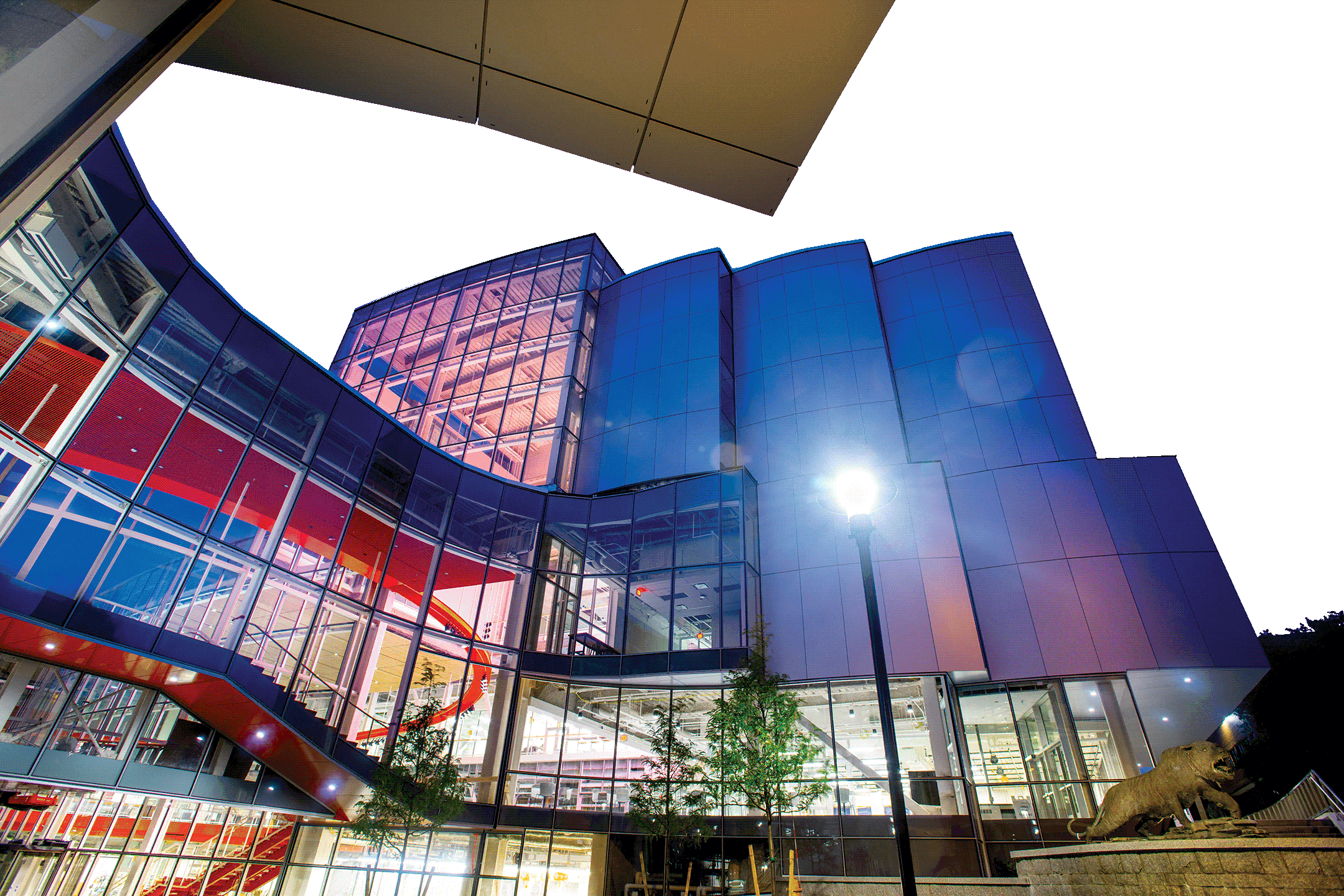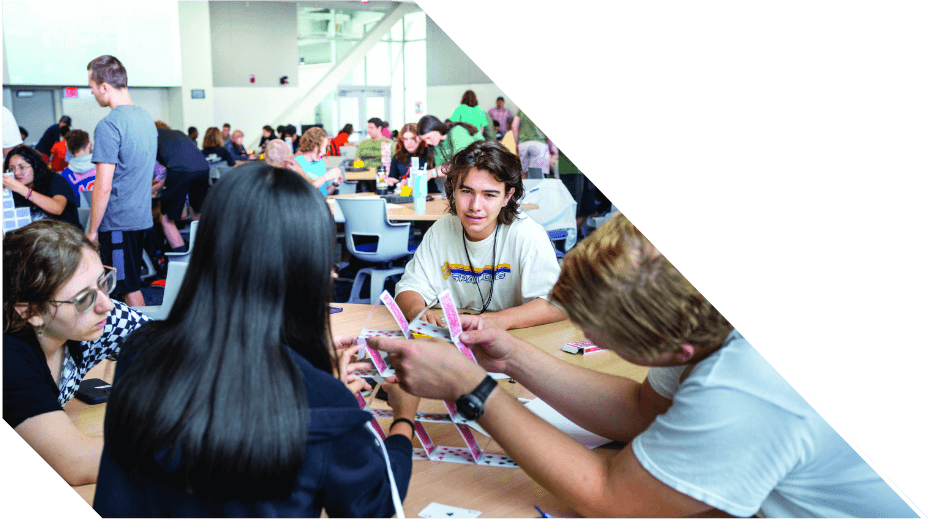Inside the SHED


The Student Hall for Exploration and Development (SHED) showcases technology, the arts, and design in one place. The complex opened in the fall of 2023.
performers, and active learners
Peli Doyle and the students at his table had 30 minutes to design and build a 12-inch observation tower out of a deck of cards and a roll of tape. The tricky part was that the students’ design had to accommodate a random pair of scissors and withstand the wind from a fan.
Teams of students sitting at more than 20 tables engaged in the same mini-design challenge in the revamped Engineering Exploration Seminar held in the new Student Hall for Exploration and Development (SHED).
“The design challenge tested our creative problem solving and was a fun activity that helped us get to know each other,” said Doyle, a first-year student from Delmar, N.Y. “The seating arrangement is better for working in groups and trying to make friends.” The Engineering Exploration Seminar has been taught for nearly 20 years at RIT for undeclared engineering majors to sample the different engineering disciplines before declaring a major. But for the first time, the entire group of 110 students can learn together in the large classrooms in the SHED. And that learning is more active.
With its five extra-large classrooms, seven makerspaces, performing arts studios, and glass box theater, the SHED complex is made for a new generation of RIT students like Doyle, who see themselves as makers and doers, performers, and active learners.
The $120 million SHED, which opened this fall, is RIT’s biggest capital project since the campus moved to Henrietta in 1968.
The SHED spans the Quarter Mile from Wallace Library to the Student Alumni Union in 209,000-gross-square-feet of combined renovated and new construction. The SHED complex includes extensive renovations in Wallace Library, including two floors of regular-sized classrooms.
An estimated 15,000 people walk through the SHED and Wallace buildings daily, drawing pedestrian traffic past the RIT Libraries’ special collections and introducing them, perhaps for the first time, to the Cary Graphic Arts Collection, the RIT Archives, and the RIT Press.
When he first proposed the new building, RIT President David Munson envisioned the SHED as a place that celebrates RIT’s inter- section of technology, the arts, and design. From the start, he predicted the SHED would become “the new heartbeat of campus.”
“We’re educating the whole person at RIT,” Munson said. “The SHED is where students can think laterally, be creative, and apply what they’ve learned in the classroom. We’ve opened the SHED doors; now watch for student start-up companies, solutions, and inventions that make the world better.”
William Rawn Associates Architects designed the SHED with layers of interior glass walls to extend transparency into the active spaces.
A 98-foot atrium towers above the first- floor hub, filling the new nexus on campus with natural light. This is where students’ paths cross on their way to class, practice, or club meetings; it’s where they hang out, study or meet friends, perform for passersby, and build a new kind of community at RIT.
Tiffany Brodner, SHED executive director, sees inspiration everywhere she looks in the glass building. “Students and groups are sharing space for the first time and even working alongside each other and making new connections,” she said. “It is exciting to think about what might be born out of the intersections of different worlds at RIT.”


New connections
For Amelia Charles, a second-year applied mathematics major from Monrovia, Md., the SHED classrooms promote interaction with her peers and her General Biology I professor.
“In a lecture hall, you could really only talk to two people at a time, if there was even anyone next to you, and now you have five other people and the professor walking around so they can be near you,” Charles said. “It’s great for learning because it establishes a better student-professor relationship. I feel more encouraged to come to office hours or ask questions.”
General Biology serves students from across campus, and Charles interacts with students from different majors, such as Ruqiah Ali, a first-year student from the physician assistant program.
“I feel like in a group setting there are more people you can collaborate with, more people you can ask,” Ali said.
Charles and Ali work together on a DNA model with other students enrolled in applied statistics, diagnostic sonography, and the physician assistant program.
Sandi Connelly, principal lecturer in the Thomas H. Gosnell School of Life Sciences, was an early proponent of active learning, a teaching style that engages students in the material and with each other. It encourages students to become active participants in their own learning.
After a brief lecture, Connelly asks her students to apply their learning to the day’s group activity—building a strand of DNA with beads and pipe cleaners. The model needs to be accurate for the following class session that will introduce RNA and proteins.
Professor Matt Marshall, associate dean of engineering, has long wanted to add hands-on learning to the Engineering Exploration Seminar based on feedback from previous classes. He jumped when the SHED presented the opportunity.
During one day this fall, a class activity focused on patience and problem solving when trying to complete a project with changing specifications. The common real-life scenario played out as student teams tried to build a house of cards for a fictitious and indecisive client.
“Engineers experience this when working with customers as a career,” Marshall said. “It’s a useful exercise for engineering students to experience because it deviates from traditional textbook problems.”
Marshall plans to take advantage of the proximity to the makerspace on the lower levels and assign students a project to build something of their choice with the equipment.
He also will arrange for students in many of RIT’s performance teams, including the seven now housed in the SHED, such as the electric vehicle Hot Wheelz team, VEX robotics club, and the aerospace Launch Initiative, to talk to his class.
“I am helping students understand that their education at RIT only begins in the classroom, that they have opportunities to learn so much more beyond their classes— including the teams and clubs and co-ops,” he said. “I think the more we can emphasize that message in their first semester, the better.”


Maker culture
Marshall’s hands-on approach to engineering exploration is working for students like Doyle, who is excited to be creating things in the SHED.
There are multiple makerspaces in the SHED. The general makerspace is strategically located in the center of the complex and offers an entry point into the world of making. The room holds basic maker staples, 3D printers, and laser cutters.
The room is attached to a classroom and a materials resource center. It’s a space to bring students up to speed or to introduce them to the equipment before they explore on their own or join a club that uses the machinery. The general makerspace is a resource for students coming in at any level of experience.
Other makerspaces are arranged thematically, said Michael Buffalin IV, SHED makerspace director. Different technologies facilitate ideation, prototyping, building, and testing, including 3D printing, woodworking, metalworking, textiles, and electronics.
“Some of the spaces in the makerspace are standard, but it’s adding to the capacity of the campus,” Buffalin said. “We have a woodshop in the College of Art and Design. So now we have a woodshop for the whole campus, which then gives groups like RIT Players (a student-run theater group) and others more resources they didn’t have before.”
The Launch Initiative team is excited to have its own space for the first time since becoming a student club in 2014. Until now, the rocketry team has used the previous makerspaces on campus and stored its rockets in a hallway in the engineering building. Even without a designated place to work, Launch Initiative took first place in July at the Space Dynamics Laboratory Payload Challenge, part of the Intercollegiate Rocket and Engineering Competition.
“Coming off this big win—and now having a space we can call home— is going to be a big morale booster for the team,” said Wynter Petersen, club president and a fourth-year physics major from Los Gatos, Calif.
The location will help the team gain visibility and grow.
“The amazing thing about the SHED is that it’s right at the center of campus,” Petersen said. “And it’s going to be a big meeting spot for a lot of different people.”

Performers welcome
Along with makers, performing artists have a large presence in the SHED through music, dance, theater classes, and clubs.
While RIT does not offer degree programs in the performing arts, more than 1,800 students participate every year through performing arts classes and clubs, including the National Technical Institute for the Deaf and RIT Performing Arts theatrical season.
Munson made performing arts a priority when he established the Performing Arts Scholarship in 2019 to attract multidimensional students to RIT. The SHED supports Munson’s mission by creating new resources for music, dance, and theatrical productions that broaden the university’s identity.
The SHED includes a jewel box for performing artists. The Skarlsky Glass Box Theater, named for Frank Sklarsky ’78 and his wife, Ruth, will seat up to 185 people for theatrical and musical performances. The flexible space includes multi-level viewpoints, retractable floor-level seating, and louvers within the glass walls to provide daylight and blackout modes.
The theater, ensemble rooms, and dance studio give faculty teaching in the School of Performing Arts room to expand course offerings, such as adding introductory vocal and music classes for students who want to get involved.
Proximity to the makerspace adds a new take on existing classes, such as the History and Technology of Musical Instruments. This year, students in this class will deconstruct a donated harpsichord in disrepair and build new instruments with the parts, said Erica Haskell, director of the School of Performing Arts.
The SHED creates a venue for new possibilities for students, such as spontaneous performances in the atrium.
“We are on the cusp of something really impactful,” Haskell said. “RIT is creating a complex performing arts ecosystem on campus inside and outside the SHED.”
Carly Wicka, a fourth-year biomedical sciences student from Buffalo, N.Y., is taking advantage of that ecosystem.
A dancer since age 3, Wicka is a leader in performing arts on campus. She joined the student dance company, Vis Viva, in her first year, and now she is one of the head choreographers for the club and
its competitive performance group. Wicka minors in dance and is enrolled this semester in a hip-hop class that meets twice a week in the SHED.
Instructor Julia Nguyen, who discovered dance while she was in college, introduced hip-hop dance to RIT’s Wellness Education in spring 2019. Now, she teaches five sections for Wellness Education and for NTID’s Department of Performing Arts.
Wicka’s dance club is excited to have the new studio in the SHED, she said. “We’re all in majors not related to dance, but we still get to come together and do something we love.”

Who named the SHED?
Jonathan Dharmadi ’22 (new media design) will forever hold a unique place in RIT history as the student who named the Student Hall for Exploration and Development (SHED).
His winning entry in the 2021 student contest to name the new makerspace and learning center has strengthened his personal connection with RIT.
“I love keeping up with all things RIT, lacrosse and hockey, and all the interesting new developments,” said Dharmadi, who lives in Queens.
Dharmadi works as a product designer at Spotify in New York City, where he creates digital ads for the music platform service. He said the project-based curriculum of RIT’s new media design program prepared him for an internship at Spotify that turned into a career. Every day he uses the design process he learned at RIT to create digital products that are both functional and visually appealing.
“As a product designer, I am doing a lot of problem solving to improve user experience and to make the content look nice,” he said.
A creative simplicity also led to Dharmadi’s prize-winning name for the new multi-use complex. For light-hearted irony, he likened the “magnificent building” to a modest shed, the kind often found in backyards, where people tinker and create.
Dharmadi, who worked as a Brick City ambassador and campus tour guide, also wanted the name to flow when spoken aloud and to underscore the spirit of the building inspired by the annual Imagine RIT: Creativity and Innovation festival.
“I first came to RIT for Imagine RIT in 2018 because I wanted to check out what it was all about, and that’s when I realized I need to go here,” he said.
When RIT’s financial aid office helped make that possible for Dharmadi, he was determined to give back to the community as a campus tour guide for admissions and through volunteer work.
“Naming the SHED will always be part of me for sure,” Dharmadi said. “It’s an honor to directly contribute to the campus like that.”









